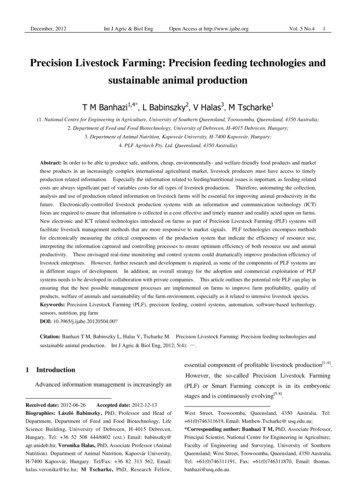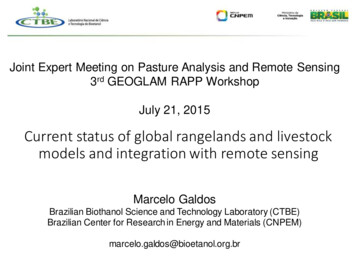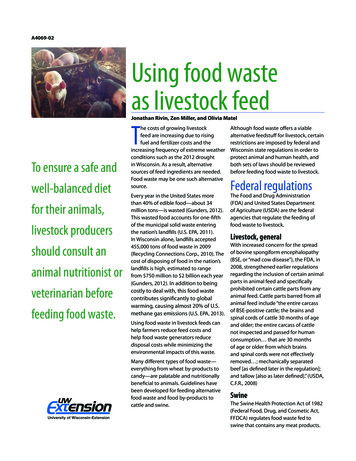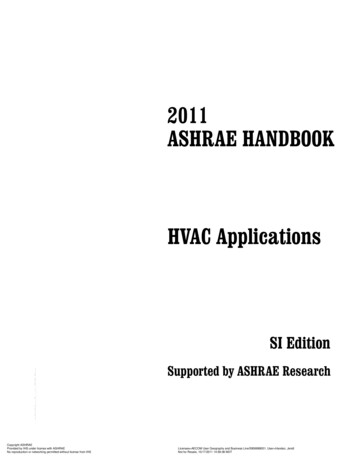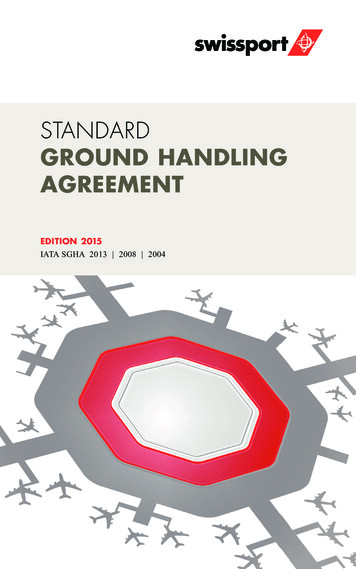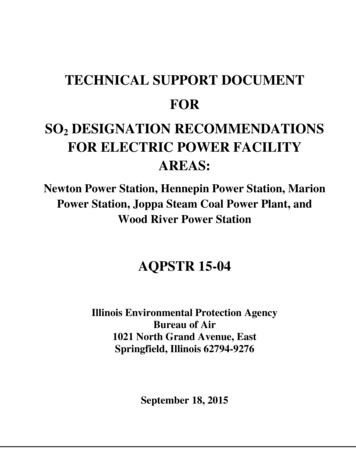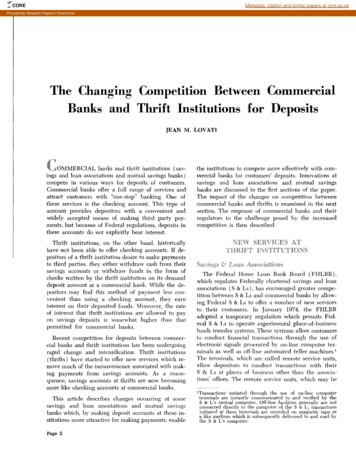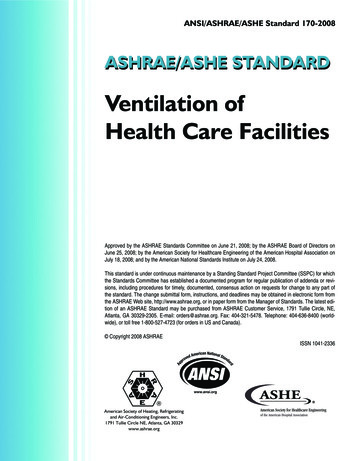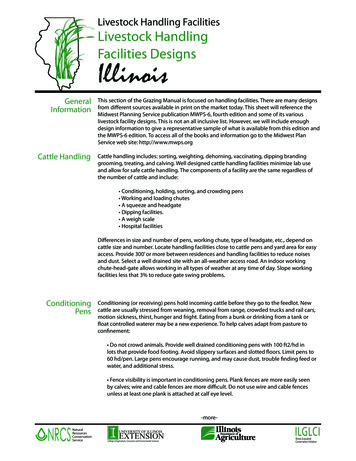
Transcription
Livestock Handling FacilitiesLivestock HandlingFacilities DesignsIllinoisGeneralInformationCattle HandlingThis section of the Grazing Manual is focused on handling facilities. There are many designsfrom different sources available in print on the market today. This sheet will reference theMidwest Planning Service publication MWPS-6, fourth edition and some of its variouslivestock facility designs. This is not an all inclusive list. However, we will include enoughdesign information to give a representative sample of what is available from this edition andthe MWPS-6 edition. To access all of the books and information go to the Midwest PlanService web site: http://www.mwps.orgCattle handling includes: sorting, weighting, dehorning, vaccinating, dipping brandinggrooming, treating, and calving. Well designed cattle handling facilities minimize lab useand allow for safe cattle handling. The components of a facility are the same regardless ofthe number of cattle and include: Conditioning, holding, sorting, and crowding pens Working and loading chutes A squeeze and headgate Dipping facilities. A weigh scale Hospital facilitiesDifferences in size and number of pens, working chute, type of headgate, etc., depend oncattle size and number. Locate handling facilities close to cattle pens and yard area for easyaccess. Provide 300’ or more between residences and handling facilities to reduce noisesand dust. Select a well drained site with an all-weather access road. An indoor workingchute-head-gate allows working in all types of weather at any time of day. Slope workingfacilities less that 3% to reduce gate swing problems.ConditioningPensConditioning (or receiving) pens hold incoming cattle before they go to the feedlot. Newcattle are usually stressed from weaning, removal from range, crowded trucks and rail cars,motion sickness, thirst, hunger and fright. Eating from a bunk or drinking from a tank orfloat controlled waterer may be a new experience. To help calves adapt from pasture toconfinement: Do not crowd animals. Provide well drained conditioning pens with 100 ft2/hd inlots that provide food footing. Avoid slippery surfaces and slotted floors. Limit pens to60 hd/pen. Large pens encourage running, and may cause dust, trouble finding feed orwater, and additional stress. Fence visibility is important in conditioning pens. Plank fences are more easily seenby calves; wire and cable fences are more difficult. Do not use wire and cable fencesunless at least one plank is attached at calf eye ERSITY OF ILLINOISEXTENSIONCollege of Agriculture, Consumer and Environmental SciencesILGLCIIllinois GrasslandConservation Initiative
ConditioningPens Provide wind protection and shelter from sun, rain snow, etc. Protected feed bunkshelp maintain feed quality and uniform consumption.(continued) Provide at least 2’ of bunk space per head. Offer hay for 8 to 10 hours before starting other roughages. Fill feeders so cattle can see hay. Start grain or silage graduallyduring the conditioning period. Provide plenty of fresh water. Be careful that calves do not over-water at first byfeeding roughage before the sound of running water helps new cattle find the waterer. Locate receiving lots away from main lots to reduce disease and parasite transmission. Process new cattle after a rest period, (usually several hours).WorkingFacilitiesWorking facilities are for sorting, handling, and treating cattle. They include the holdingpen, crowding pen, working chute, squeeze and headgate, scale, and possibly a dipping orspraying facility.Holding orSorting PenMake the holding pen about 60 ft2 (12’ X 50”, 20’ x 30’, etc.) to hold 40 to 50 animalsahead of the crowding pen. One is sufficient for operations with up to 250 cattle. For largeroperations provide: Up to 1000 head, one 600 ft2 pen/250 head. Over 1,000 head, four 600 ft2 pens and two 1000 ft2 pens.Where cattle are moved by person on foot, provide safety posts in each corner and at 40’– 50’ intervals along the sides of large pens, fig 7-1 (last page of fact sheet). In larger pens,locate safety posts every 50’. Position posts 3’ -4’ from fences and corners. Use at least 6”posts set 4’ in the ground. Safety posts are essential when handling bulls.Crowding orFunnel PenWorking ChuteA crowding or funnel pen with a swinging gate is needed to crowd into the working chute.Taper the pen from 12’ to about 2’ at the chute entrance. A circular crowding pen withsolid fence and gate is most effective because the one escape route the cattle can see isthrough the working chute. Equip all gates with self-locking latches and provide a safetyexit from the crowding area.Desirable characteristics are: Curved chute construction with solid sloped sides that restrict cattle vision to a fewfeet straight ahead. A minimum curve radius of 15’ is recommended. Sloped chute sides that restrict an animal’s feet to a narrow path and prevent turningaround. Sloped sides permit working different sized animals in the same chute. An overhead restrainer to keep cattle from rearing up and turning around or fallingover backwards. At least a 20’ long chute to hold 3 or 4 head at one time. One person workingthe crowding pen can keep the chute charged to reduce delays at the squeeze andheadgate. Use one or two blocking gates to keep cattle from moving forward or backing up.Use these near the scale or cutting gates. Use a cutting gate at either the beginning of a chute, or just ahead of the squeeze,or at both places, to divert cattle not requiring treatment. Cutting gates are better thanrunning all cattle through the squeeze and headgate.-more-
Working Chute(continued) A concrete floor or other all-weather surface should be installed for easier cleaning.Use a sloped (less then 4%), rough finished surface for good traction. See the buildingconstruction chapter for slip resistant floor surfaces. Chute sides should be about 4” above the ground to improve manure removal andcontrols insect breeding.Squeeze andHeadgateA squeeze and headgate restrains cattle for treatment. Usually a headgate on a stall withfixed sides is satisfactory for small cow-calf operations. A squeeze provides faster, morecomplete animal control, reducing the chance of injury to animals or operators, Fig 7-2.Consider a tilting table in the squeeze-headgate area for branding, castrating, hooftrimming, and treatment. Select a headgate which opens the full width of the chute toreduce cattle injuries. Size the chute and headgate based on cattle being worked. Threeheadgate types are: A self-catch headgate is easiest for one person to operate; cattle work fast, exit easily,and seldom choke. Is difficult to use for small or horned cattle and can cause severshoulder bruises. Sometimes animals escape without being caught. A stanchion headgate is lower cost, simple, requires an operator, and seldom chokescattle. It can cause shoulder bruises and sometimes allows a animal to escape withoutbeing caught. Cattle often rip as they walk through the headgate. A guillotine headgate holds the animal’s head down, providing maximum headcontrol and reducing shoulder bruises. This headgate is medium cost, difficult tooperate, slower, and of the three types is most likely to cause choking.The self–catch and stanchion headgates are available in straight bar models. A straight barprovides less head control and decreases chances of choking. A curved bar gives betterhead control, but increases the possibility of choking.Hospital PensProvide 40 - 50 ft2/head of hospital space for 2-5 percent of the finishing and adult cattle.Do not over crowd sick animals. Provide one hospital area for every 6,000. Locate this areaclose to handling facilities and conditioning lots. Provide separate drainage. Use roughenedconcrete sloped ¼”/ft or more to a drain for outdoor hospital pens.More than one hospital/treatment area is recommended for large custom operations.Separate this area to reduce disease transmission. Clean and disinfect before putting newgroups of cattle in.Heat and mechanically ventilate tight, well insulated room and intensively used barn areas.Space to drive a veterinarian’s truck into the treatment area is desirable.TreatmentSupply RoomProvide a small insulated and heated building or a room near the treatment area to storeequipment and supplies used at the squeeze chute and headgate. Provide a refrigeratorfor veterinary supplies and lock this room when not in use. Where large numbers of cattleare treated regularly, install a water heater and sink with hot and cold water. Consider anemergency shower head in case of contamination with treatment products.ManagementThoroughly clean treating, handling, hospital, and barn areas during the early part of thesummer. Use white wash containing cresol (a disinfectant), or equivalent, for washing walls,posts, and other surfaces. Cresol helps control ringworm and lice caused by cattle rubbingagainst walls. Heavily spread dry lime on floor areas about 30 days before use.-more-
ReferencesThe following diagrams and designs are from the MWPS-6, fourth edition.Also of these and other livestock information books can be accessed from the Midwest Planservice web site at: http://www.mwps.orgFig 5-7 Pasturecorral withrotational grazingFig 7-1 Safety postplacement-more-
Fig 7-2 Cattle handling layouts for up toabout 75 headFig 7-4 Cattle handling facilityFig 7-3 Small rectangular corral-more-
Fig 7-5 Cattle handling facilities for300 to 1,000 headFig 7-8 USDA corralplans 6229 and 6230Fig 7-9 Low bed trailer loadingDecember 2006The U.S. Department of Agriculture (USDA) prohibits discrimination in all its programs and activities on the basis of race, color, national origin, age, disability, and where applicable, sex, marital status, familial status, parentalstatus, religion, sexual orientation, genetic information, political beliefs, reprisal, or because all or a part of an individual’s income is derived from any public assistance program. (Not all prohibited bases apply to all programs.)Persons with disabilities who require alternative means for communication of program information (Braille, large print, audiotape, etc.) should contact USDA’s TARGET Center at (202) 720-2600 (voice and TDD). To file acomplaint of discrimination write to USDA, Director, Office of Civil Rights, 1400 Independence Avenue, S.W., Washington, D.C. 20250-9410 or call (800) 795-3272 (voice) or (202) 720-6382 (TDD). USDA is an equal opportunityprovider and employer.
Livestock Handling FacilitiesPasture and CorralHandling BasicsIllinoisGeneralInformationHere are some tips to keep in mind when handling livestock in the pasture and corrals.This is a very brief summary of some of the Low Stress Livestock Handling methods thathave been perfected by Bud Williams and captured in print by Dr. Temple Grandin fromColorado State University. For more instruction on Low Stress Livestock Handling go to theweb link provided under references.In the Pasture Remember flight zones. Use just enough pressure to move an animal without sendingit over the fence. Point of balance. Livestock tend to move forward if you are “behind” their shoulderand backward if you are “in front” of their shoulder. If livestock won’t move forward inan alley way, try putting down a hotshot and walking by them from front to back. Take your time. It is faster to do it right the first time than to do it twice. Keep moving. People in motion are easy for the livestock to see and relate to. Whenthe motion stops, livestock get nervous. Their instinct is to turn around and clearly seewhat stopped, because it may be something with big teeth ready to pounce on them.Move back and forth behind a group of livestock, don’t follow straight behind them. Walk in straight lines, not in curves. Guide the front animals, not the middle of the herd. The majority of the herd willfollow the leaders. Don’t stop when you reach an open gate. The livestock should know there is a gatethere, so go ahead and put them through it at a reasonable pace. When you stop to“let them find the hole,” they turn around and face you because you took all of thepressure off. Then you have to turn them around again and start all over. It is easier justto go straight through. Cull animals that are consistently wild or aggressive.In the Corral Eliminate shadows, trash, chains etc. These things distract animals and cause them tobalk. Don’t yell. Remove any protruding bolts, nails, sharp corners, etc. that can cut livestock NIVERSITY OF ILLINOISEXTENSIONCollege of Agriculture, Consumer and Environmental SciencesILGLCIIllinois GrasslandConservation Initiative
In the Corral(continued) Eliminate noisy chutes, headgates, etc. Always have an escape route in mind. Don’t fight an animal that gets mad, because one of you will get hurt. It doesn’tmatter if “the animal wins.” Remember that livestock like to go back where they came from. Use that to designfacilities that help you get animals into the crowd tubs, to sort them, etc. Don’t over fill the crowd tub and lanes. Don’t put a back-up gate right at the entrance of the lane from the crowd tub. It willcause the animals to balk. Put it one body length up from the entrance. Hotshots are a big can of worms. I think about hotshot use like this: Image thatthe hotshot has a short in the handle, and every time you shock an animal, you getshocked yourself. You can still use it when absolutely necessary, but that will cut downunnecessary uses. Take your time. We want to be efficient with our time, and we don’t want to stressanimals by making them stand longer than they have to. However, unlike the Olympics,there are no gold medals handed out for those who do it the fastest. Oftentimes, thatanimal would have moved if you had just waited two more seconds before using thehotshot. Before you go to handle livestock, discuss the plan and goals with your crew.The following four diagrams show potential designs for handling animals.ReferencesFor more information about safe and effective livestock handling, go to e.html on the web.“To really test a marriage, have a husband and wife sort cattle together.” ByDr. Ron Hanson, Univ. of NebraskaBy: Ryan Reuter with the Samuel Roberts Noble Foundation, Inc.Dr. Temple Grandin is nationally known for here work on Livestock Corral designs andanimal behavior research. Attached are a few of her corral designs. This and much moreare located on her web site: http://www.grandin.com-more-
Basic Forcing PenBasic Cattle Layout-more-
Corral for 150 Cow/Calf PairsRestricted Space Forcing Pen PlanDecember 2006The U.S. Department of Agriculture (USDA) prohibits discrimination in all its programs and activities on the basis of race, color, national origin, age, disability, and where applicable, sex, marital status, familial status, parentalstatus, religion, sexual orientation, genetic information, political beliefs, reprisal, or because all or a part of an individual’s income is derived from any public assistance program. (Not all prohibited bases apply to all programs.)Persons with disabilities who require alternative means for communication of program information (Braille, large print, audiotape, etc.) should contact USDA’s TARGET Center at (202) 720-2600 (voice and TDD). To file acomplaint of discrimination write to USDA, Director, Office of Civil Rights, 1400 Independence Avenue, S.W., Washington, D.C. 20250-9410 or call (800) 795-3272 (voice) or (202) 720-6382 (TDD). USDA is an equal opportunityprovider and employer.
Livestock Handling FacilitiesSheep and Goat Handlingand Facilities OptionsIllinoisWhy Handlingand Facilitiesare ImportantDetermine Whatis NeededProfit, pride, good husbandry, instincts and training are the reasons that sheep andgoat producers concentrate on care and management of their sheep and goats. Goodmanagement shows the producers that with proper handling and management skills, theresult is comfortable, contented and productive animals. Experienced producers soonrecognize that well-designed working facilities and buildings reduce work and physicalexertion required to provide the necessary care for sheep and goats. This reduces tress onboth the livestock and herder. Management jobs, such as health care, are scheduled andperformed in a timelier and routine manner when good facilities are available, rather thanbeing avoided or ignored due to lack of proper handling corrals and chutes. Also, carryingout these jobs is possible in a more humane manner with less risk of injury to the animalsor handler. Finally, the animal’s wool or hair is maintained cleaner and in a valuablecondition. It is important to remember that proper handling and use of a well-designedfacility will increase productivity and profit from the sheep and/or goat operation.What constitutes adequate handling facilities? If you have fewer that 200 sheep or goats,adequate facilities can be made from a few portable 8-foot panes and a few specialpurpose metal gates. Figure 33 shows how these panels and gates can be quickly arrangedin an existing corral or building to form a simple, effective layout. For larger flocks, amore permanent handling facility should be considered. This will require some additionalthought and planning.First think about what sheep or goat management jobs need to be done on your farm orranch. Make a list of these jobs. Beside each job, note what time(s) of the year it is doneand the number of animals handled at each time.This list will help you determine the facilities you need for your management system. Forexample, some shepherds control external parasites by dipping their sheep, others byspraying. Each of these techniques requires different types of facilities. It will also help insetting the priority since it points out the frequency of each task and the number of animalshandled at any one time. In addition, items which require the most thought in design andspecial attention on construction will be identified. For example, the number of animalshandled at one time determines the dimensions of the pens and chutes. If holding pens aretoo large, you’ll waste time and energy chasing the animals. If too small, you’ll waste timeand energy moving sheep from pen to pen. Allow about 4-5 square feet per sheep or goatsfor holding pens. When completed, your list might look like ingFoot y RequiredGathering pen and forcing penNarrow sorting chute, sort gate,At least two holding pens to sort into3’ wide chute or small pen3’ wide chute or small penWeigh crate in chuteTip crate or small pen-more-UNIVERSITY OF ILLINOISEXTENSIONCollege of Agriculture, Consumer and Environmental SciencesILGLCIIllinois GrasslandConservation Initiative
Determine Whatis Needed(continued)ReferencePrepared byAdd or delete items and list the number of animals, as well as times to handle, to suityour situation. During the planning process, keep in mind a few basic principles. To workeffectively, your facility should enable you to gather and hold your animals in a gatheringpen, move them into a forcing pen, which will in turn allow you to force them into thetreatment and sorting area, and then out into sort pens. To successfully get sheep toflow through pens with a minimum effort and stress on both you and the animals, basicprinciples of sheep and goat behavior should be understood.The reference material for this article largely came from the Sheep Production Handbook.For more information on sheep handling principles and management contact the:American Sheep Industry Assoc., 6911 S. Yosemite, Englewood, Colorado 80112-1414;Phone: 303 -771-3500: web site: http://www.sheepusa.org/Roger Staff, NRCS Grazing SpecialistFigure 33.Simple Layoutfor Small Flocks-more-
Figure 34.Possible SimpleLayout for SmallFlocksFigure 35.Possible SimpleLayout for FarmFlocks up to800 EwesDecember 2006The U.S. Department of Agriculture (USDA) prohibits discrimination in all its programs and activities on the basis of race, color, national origin, age, disability, and where applicable, sex, marital status, familial status, parentalstatus, religion, sexual orientation, genetic information, political beliefs, reprisal, or because all or a part of an individual’s income is derived from any public assistance program. (Not all prohibited bases apply to all programs.)Persons with disabilities who require alternative means for communication of program information (Braille, large print, audiotape, etc.) should contact USDA’s TARGET Center at (202) 720-2600 (voice and TDD). To file acomplaint of discrimination write to USDA, Director, Office of Civil Rights, 1400 Independence Avenue, S.W., Washington, D.C. 20250-9410 or call (800) 795-3272 (voice) or (202) 720-6382 (TDD). USDA is an equal opportunityprovider and employer.
An overhead restrainer to keep cattle from rearing up and turning around or falling over backwards. At least a 20’ long chute to hold 3 or 4 head at one time. One person working the crowding pen can keep the ch
